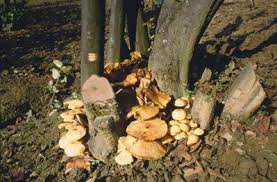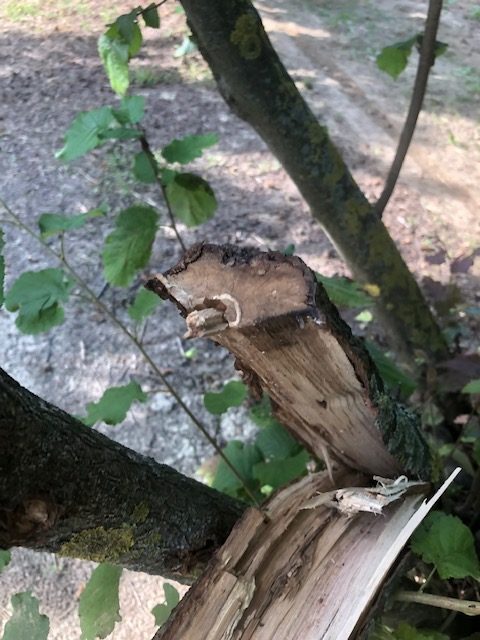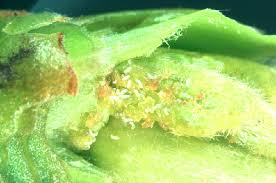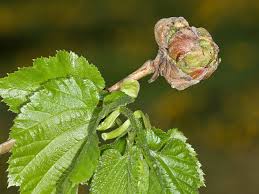Pathogens
Cryptogams
Powdery mildew or white hazel blight (Phyllactinia guttata)
fungus with manifestations typical of powdery mildew but almost exclusively on leaves. Attacks in late summer cause premature leaf fall. Treatment is rarely necessary as the pathogen is already controlled with calendar treatments for other pests.
Gleosporium (Piggotia coryli)
Fungus that affects buds, which undergo desiccation at vegetative regrowth and sometimes this alteration can also affect twigs. The affected buds appear darkened, with fruiting of the fungus identifiable by the characteristic dark stippling. Symptoms on the leaves are desiccation known as drop blight. The strongest attacks are more evident in particularly wet years and in hazelnut groves on the valley floor. Should it become necessary, intervene in autumn, at mid-leaf fall.
Dislocation disease (Cytospora corylicola)
manifests itself mainly on old plants with the appearance of characteristic reddish-brown spots on the bark of the branches. Affected plants show poor vegetative vigour and tissue necrosis. It is important to remove and burn the affected branches and intervene with copper-based products to prevent the disease from spreading. Branches tend to split, usually as a result of snowfall or in the event of heavy production due to the weight of the fruit. A particular characteristic is that where the branch breaks, a clean cut can be seen, as if caused by mechanical means or a saw cut.
Root rot (Armillaria mellea)
fungus affecting the root system. The plants show little vegetative vigour, absence of suckers and often wilting and collapse dryness. Typical of wetter soils, in the event of attacks, it is advisable to remove infected plants by removing the entire root system and leaving the hole open so that fungal activity stops in the summer season before replacing the plant. It is important to sprinkle the hole with copper salts.

Mites and Insects
Eriophid (Phytoptus avellanae)
Pest that overwinters inside the buds, turning them into characteristic galls and causing them to die. At the end of March/beginning of April, the migration of the eriophids on new twigs occurs from the affected buds to the buds in the process of formation. The young affected buds show an abnormal development, swelling rapidly and taking on a reddish colour. The Tonda Gentile variety is particularly sensitive to the eriophid, which can adversely affect plant development and production capacity. It is controlled during migration with sulphur-based products.
Hazel plover (Culio nucum)
hazelnut-coloured curcuglionid, equipped with a rostrum that in females is as long as the body. Adults appear in hazel groves from April to May and after a feeding period that serves the females to mature their gonads, mating begins from mid-May to mid-July. The rostrum is used by the female to pierce the nut shell and lay the egg inside. Each female lays about 20-30 eggs and the larva after a 10-day incubation period hatches and completes its development inside, feeding on the kernel. After 30-35 days at maturity it emerges by piercing the shell. Usually the balanino is controlled with treatments carried out to combat the bug. By carrying out frappage sampling (shaking) if the number of adults is high, it is necessary to intervene with targeted treatment.

Bug
Insects in which the juvenile forms sting the growing nuts causing damage. The stylets of the mouthparts are able to reach the spongy tissue or the developing seed by passing through the shell causing traumatic abortion. The bug bites continue even when the nut shell has already hardened and the seed inside occupies the entire fruit cavity. The saliva that the insect injects with the sting renders the seeds inedible (spoilt taste) and in any case unusable by the confectionery industry. The stings made by some species on hazelnuts already formed before ripening cause very serious commercial damage as they give rise to a damaged seed with no distinguishing marks to recognise it (occult bug). It is certainly the most difficult disease to control as there are few active ingredients authorised for control and they are often not very effective. It is necessary to intervene with targeted interventions (calendar-based strategies that hit beneficial insects and damage the plant’s balance are to be banned) based on sampling carried out with different techniques. Calculating the intervention threshold for each species and the presence of eggs parasitised by natural antagonists.
- Gonocerus (Gonocerus acuteangulatus) is a very dangerous bug for hazelnut trees as it can carry out its entire cycle on the plant. Very polyphagous and can live on many host plants, both wild and cultivated. Particularly popular plants that can be used as bait for monitoring: dogwood, hawthorn, dog rose, cherry, peach and apricot trees. It appears in hazelnut groves from May beginning of June and causes severe damage during seed fertilisation. Monitoring is by frapping (shaking).
- Coreus marginatusor vegetable garden bug(Coreus marginatus) is not a typical corylicola bug as it prefers vegetables and wild flora. It can be confused with the gonocero but there are very clear distinguishing features. It can cause serious damage to horticultural plants. My own research has shown that white mulberry trees are particularly attractive; a plant placed near a vegetable garden can attract the entire population of the surrounding area during its very long fruiting period.

- Palomena (Palomena prasina) unlike the gonocero, although it lays its eggs on leaves, the early juvenile stages prefer wild grasses and shrubs on which they drop after birth.
- Nezara (Nezara viridula) bug that only occasionally occupies hazel groves, prefers horticultural environments, overwinters in various shelters including homes (it is the classic green bug that we always find in homes)
- Grey bug (Raphigaster nebulosa) like the other species occasional host of the hazel tree where it goes to lay and where it is present mainly in juvenile forms
- Wood bug (Pentatoma rufipes) as its vernacular name suggests is a typical bug that loves wooded areas, it can strike hazel groves located near woods. All bugs of the species Coreo marginato, Palomena, Nezara, Grey Bug and Woodland Bug usually do not cause serious damage to hazelnut groves and, being native insects, often have natural antagonists that parasitise their eggs. They are usually controlled by interventions for the Gonocero but care must be taken as there may be cases, in some limited areas, of an explosion of the species. They are detected by frapping for Gonocero and in the case of significant numbers the relevant defence strategies are implemented.
- Asianbug (halyomorpha halys) an exotic bug of Asian origin that made its appearance in North America and then in Europe. In 2012 it was reported in Emilia Romania and Veneto, in 2013 in a peach orchard in the San Benigno district of Cuneo. A very dangerous bug for all crops, invasive as each adult lays 200 to 300 eggs. In its tropical areas of origin it can perform up to 4 – 5 generations a year, becoming devastating. In Italy, after its appearance, it has expanded its area of occupation, causing very serious damage to agriculture, catching farmers and technicians unprepared. Today it is being studied and researched by the relevant bodies. Last year, the hazelnut tree caused very serious damage in the Fondovalle Tanaro area, in the Province of Turin and in the lower Roeri area. According to recent studies, it seems to carry out two generations with overlapping. Its danger lies in the fact that it can pierce completely formed hazelnuts ready for harvesting with its stiletto, giving rise to occult spoilage. This is the brown bug that we often found in homes and buildings in general last winter. It will be a problem in coryliculture where, with correct agronomic practices and technically well-designed plants, it can be efficiently controlled. After overwintering in buildings and dwellings in May, it moves in search of host plants that it likes. It is extremely prolific and can live on around 200 plant species, moving from one plant to another according to its needs. After the first generation at the end of May/beginning of June, it goes on to carry out a very important second generation at the end of June/beginning of July, giving rise to a very important population which, having reached adulthood, will overwinter the following year. Our technical structure is extremely attentive to the problem and is looking for all agronomic, phytosanitary and natural methods to stem the infestation. In 2016, a natural antagonistic micro-imenoptera (ooencyrtus telenomycida) was selected that is able to parasitise 35% of the eggs in 24 hours and in the presence of several females reach 100%. It lays an egg inside the bug’s egg and the larva after hatching feeds on it, reaching maturity. Special agronomic practices, correct execution of treatments and accurate monitoring are important and can be carried out using pheromone attractant traps for aggregation.
Agrilo (Agrilus viridis)
is a beetle that generally carries out one generation per year. Adults appear around mid-May and the whitish or orange-coloured eggs are laid on the bark of branches. The larvae dig deep tunnels, partially or totally interrupting the lymphatic vessels, causing yellowing of the foliage, stunting of the vegetation and early leaf fall. Characteristic is the spiral swelling of the affected branches. The plant can hardly recover and is doomed to die. The prolonged presence of the insect in the hazelnut grove makes an effective defence programme difficult. Agronomic practices consisting of cutting off all affected branches and burning them are essential. Adequate fertilisation reduces infection as, in the plant with the greatest vigour, the larva is unable to complete its cycle.






